WAVERLEY RESIDENCE
Anderson Architecture
The decision was made early on to maintain the core sustainable features and make sacrifices in other areas so that the building performed as intended.
Having a mild Sydney coastal climate allowed the design to focus on providing both indoor and outdoor spaces that would be comfortable in all seasons and weather conditions. Exceptional passive solar design as well as; enclosed balcony's, sheltered roof terraces, operable deck roof and deciduous trees, mean that there are always comfortable spaces without the need for extra heating and cooling.
The most significant challenge was to provide good passive solar design on a southerly sloping site and with an 8.5 metre high neighbour immediately to the north, built close to and on the boundary. This was eventually achieved without overshadowing the neighbour to the south, sacrificing internal layout or over-exposure to the east and west.
In the combined interests of sustainability and cost management, all onsite waste was recycled, waste timber was reused for non-structural framing and the project staged to maximise efficiency by reducing double handling etc.
INITIATIVES
-
HERS 7.5star thermal performance rating.
-
Thermally broken aluminium windows with low E double glazing.
-
Adjustable external shading louvres and screens.
-
CBUS controlled shading and ventilation.
-
Predominantly LED light fittings throughout.

-
Solar powered hydronic floor heating to ground floor and 1st floor bathrooms.
-
Externally insulated floor slab and reverse brick veneer walls.
-
Central masonry wall to act as heat sink in summer and solar storage collector in winter.
-
14KL rainwater tank catching all roof water and providing stormwater OSD and buffering.
-
All plumbing fixtures and fittings have high efficiency ratings.
-
Extensive soft landscaped areas and very limited hard surfaces to minimise surface water runoff.
-
Resource efficiency
-
Efficient use of floor area to provide 4 bedrooms, 2 living areas, 2 bathrooms and an ensuite within 220 square meters.
-
'Green' concrete with recycled and waste components.
-
Where materials with high embodied energy have been used they are detailed and protected to ensure maximum service life.
-
Recycled and sustainably sourced local hardwoods.
-
What was particularly innovative in ESD terms about this project?
-
Due to the extremely limited northern exposure, extensive glazing to the east and west was required. To prevent summer overheating, while still allowing for maximum winter solar gain, an active climate control system running from a central CBUS system was developed. Anderson Architecture designed a protocol set that controls the amount of solar exposure and ventilation based on information received from sensors for wind speed and direction, indoor and outdoor temperatures, rain and logarithms determining sun angle. The active components in the building are:
-
Retractable external venetians
-
Operable vertical elliptical blade screens
-
Operable 'moving roof' over the rear deck
-
Motorised double glazed louvre windows
-
Motorised skylights
-
This system combines with other passive features such as fixed eaves, grape vines on pergolas, deciduous planting to provide a comfortable indoor climate with minimal reliance on external heating and cooling inputs.
-
Rotex solar hydronic floor heating and hot water supply. The floor heating meets all of the heating requirements for the house and has been incorporated into the ground floor slab as well as the 1st floor bathrooms.
-
AWS commercial thermally broken window frames. This was one of the very first projects to use this product in Australia.
-
Recycled and sustainably sourced blackbutt timber for timber windows, flooring, decking, pergola and stair. This hardwearing timber has the potential to last for many years and is recyclable.
-
Boral green star concrete has been used throughout the project.
-
Natural and low VOC paints have been used exclusively for the internal painting.
-
All joinery used zero VOC board and low VOC finishes.
Photogapher: Nick Bowers
HILLSIDE PROJECT
Avers Design
The brief was to create a minimalistic, contemporary home with a resort feel that maximises the magnificent views of the Adelaide coastline. The priority was to build a sustainable and fire safe home with an open and airy feel with the main living area on one level (opening outside) and a separate children’s space.
The 3000m2 site in the Adelaide Hills slopes considerably, with expansive views to the west, which the client wanted to accommodate. It fronts bushland and is in a high fire danger zone. The client wanted minimal disturbance to the natural slope of the land. Privacy – including preserving neighbours’ privacy – was essential, as was preserving neighbours’ views. All of these factors, coupled with difficult site access presented a range of challenges to accommodate the principals of sustainability.
The temperature range can be 0degC in winter to 45degC in summer. Winds and wind chill factor contribute to temperature variation throughout the year. The surrounding bush land environment is also threatened by bushfires.
A split level home with 4 hour fire-rated R3.04 insulated precast concrete sandwich panels with heat reflective coatings, double-glazed fire-rated windows/doors with remote blinds and R5.5 ceiling insulation was built. Passive solar gain and cross-ventilation was included.
Hillside’s greatest contribution toward a more sustainable built environment
is the minimal impact it has on infrastructure & utilities due to self-sufficient power generation, rain water harvesting, double glazed energy efficient windows, thermal massing in floors and walls, heat reflective coatings, CBus automation, controlled ventilation & shading components, high level insulation provision, water efficient fittings & fixtures and drought tolerant landscaping.
INITIATIVES
-
Insulated precast concrete sandwich wall panels for walls (R3.04)
-
Double glazing, fire-rated windows/bifold doors
-
Automated UV blockout blinds on Western windows
-
CBus automation throughout
-
Hydronic in-floor heating throughout
-
Roof mounted PV solar panels
-
Heat reflective coatings on walls and roof
-
R7.5 insulation in ceilings/roof
-
Stormwater and rainwater collection
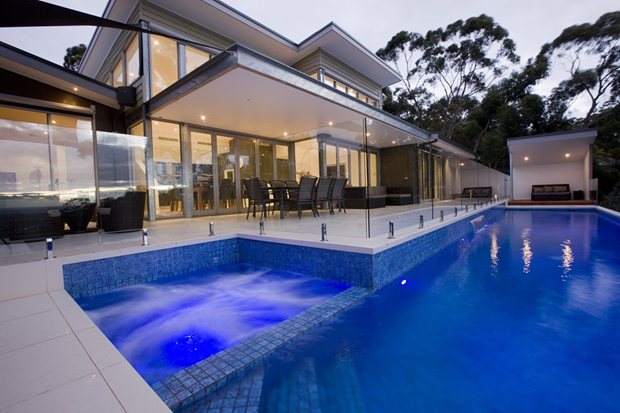
-
Low energy/water appliances
-
Drought tolerant plants in landscaping
-
The building is set up for the use of recycled grey water for toilet and irrigation use when South Australia embraces the technology.
-
Precast concrete wall panels have a long life (at least 100 years) and therefore buildings can be simply refitted rather than demolished. They will also withstand fire, unlike alternative materials, allowing reuse after fire. Precast panels can also be disassembled and re-used, or can be easily crushed and re-used.
-
Precast concrete is made from locally supplied (not imported) natural materials, predominantly sand, water and aggregates, all of which are in abundant supply. Whilst the cement in concrete has a high embodied energy, this is well and truly overtaken by the environmental benefits during manufacture, construction and over the life of the building (see next question).
CSR HOUSE
CSR Building Products
CSR Building Products Ltd. has built the CSR House, an 8 Star home at 75 Townson Road Schofields, NSW. CSR House is a two-storey, 3/4 bedroom, three bathroom dwelling with a double garage, dine-in kitchen, two living areas and an alfresco BBQ area.
CSR aimed for energy efficiency at an affordable price, without sacrificing style. CSR House is a contemporary designed home, sized to reflect modern Australian family needs.
One of the key innovations from a sustainable design point of view was the intent of the home to not look out of place in any display village around Australia. The homes look & layout is tangible to the mainstream market and does not alienate price sensitive home buyers. A composite facade using a minimum of three unique materials & textures was required to reflect the design intent of most modern Australian homes.
Passive solar design principles were employed to maximise solar access in winter while screening hot summer sun by locating windows and shading devices in strategic positions, using windows to capture prevailing winds allowing cross flow ventilation to cool the home in summer, introducing skylights to entry portico and alfresco area to capture natural light, the use of internal doors giving the ability to effectively zone the home when heating and cooling to minimise energy use.
INITIATIVES
-
75per cent less heating and cooling energy than the average Australian home1 (2.75 stars2)
-
45per cent less heating and cooling energy than the average 6 star home1
-
1 NatHERS Star Bands climate zone 28
-
2 Average Australian Home based on CSR Research
-
CSR House was also modelled in the top 23 NatHERS climate zones around Australia (representing 85per cent of housing approvals) to demonstrate flexibility in design, results varied from 7.2 to 8.4 stars. Ignoring tropical climates (Cairns & Townsville) the minimum performance of this study was 7.6 stars.
-
A non-toxic lead free polymer based flexible exposed roof flashing was used on the house to enable the captured rainwater to be potable. Rainwater is stored on site and used to flush toilets and the cold supply to the washing machine in the laundry.
-
Products and materials were selected based on a number of criteria
-
Embodied energy (see 1.9 LCA below)
-
Low VOC and toxicity content
-
Locally sourced
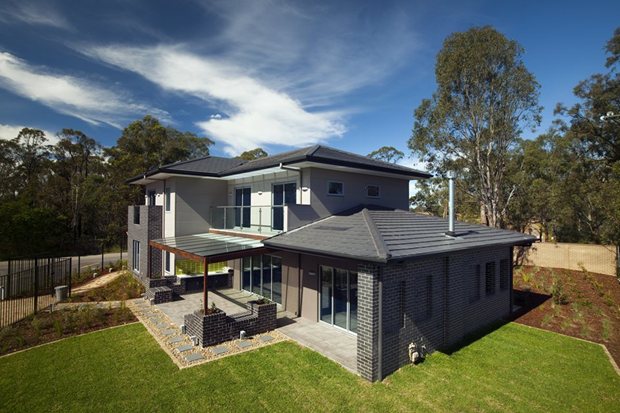
-
GECA certified where possible
-
Products with recycled content used in manufacture include, Bradford Gold Insulation, Gyprock Supercheck & Superceil and Holcim EcoMax Concrete.
-
Energy efficient appliances (Blanco & Omega), lighting (Philips), hotwater service (Hills Solar) & air conditioning (Actron), bench tops using bio resins (Smartstone) were also chosen for the CSR House.
-
The CSR house has over 144 different sensors located in all parts of the buildings fabric, under the building in the ground around the dwelling all designed to capture heat flow, moisture, humidity and temperature variance year round, a full weather station crowns the top of the roof. The sensors take readings every 5 minutes, recording an average of these readings every 15 minutes.
-
CSR House used conventional building practices and the overall construction timeline was representative of a typical current house construction schedule.
-
During construction CSR undertook research into construction techniques to identify opportunities for more efficient construction systems. This included a review of the frame and truss supply chain with the aim to unlock value and minimise material waste in the delivery of the building structure.
-
All construction waste was segregated from general waste for recycling, eg. bricks & masonry products, timber, and Gyprock plasterboard.
IWONA KLASICKI
Chris and Wendy House
The site owner, who sold the client part of the land, made a sale condition that the house on it needs to be designed and built in an environmentally sensitive and sustainable way.
The clients brief was to subdivide the site into two small lots and then to build environmentally sustainable, durable and economical houses.
INITIATIVES
-
Several passive design principles were instigated to increase comfort and minimise the need for heating and cooling.
-
The house heat loads were minimised with its orientation, insulation and shading.
-
A highly efficient energy rating label was chosen for white goods (refrigerator, clothes washer and dishwasher) and appliances.
-
LED lighting and fluorescent and compact fluorescent lamps, task lighting, separate switches for each light fitting throughout the home were installed.
-
Ceiling fans were chosen instead of air coolers.
-
Clerestory windows, eaves and high ceilings were designed to allow heat to exit the building.
-
Conventional techniques and materials were used in the construction of this house and special materials and construction details were kept to a minimum.
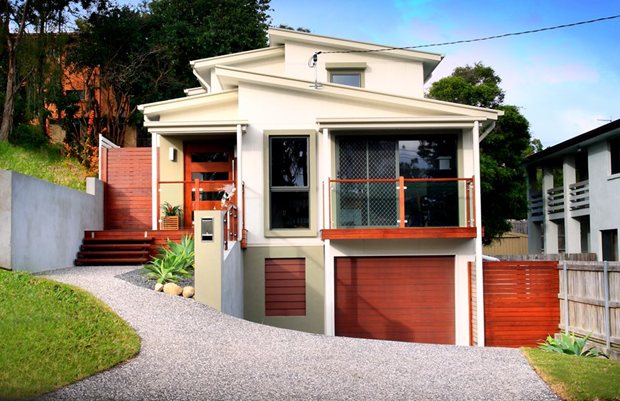
-
Materials and low mass construction systems were combined with insulation and cross ventilation that could increase thermal comfort, lower construction and maintenance cost and reduce the environmental impact of a home without adding to the cost.
-
They include lightweight construction system, suspended floor construction, green roofs and walls. The suspended flooring minimise the amount of cut and fill on this fairly steeply from northeast to west to southwest site.
-
Consideration was also taken in to the lifecycle of materials and minimising the transport miles to the site by using locally produced / available and lightweight materials, the energy used to transport them was minimised.
-
The owner will use retained excess, usable building materials to build houses on the other lot.
-
Bamboo flooring which is durable and is a highly renewable wood was chosen for most of the inside house floor coverings.
-
This house orientation on its site not only suits the sun but also suits the direction of prevailing breezes/ winds.
-
Design and house layout allows cool breezes to pass right through the house and allow air to flow over the top and through the whole house.
-
Different levels of occupations are provided to suit site natural slop.
-
To make it look more specious inside, the house floor plan is structured, sparse and uncluttered.
-
The garage is located on the south-western corner as it is a non-habitable room and can reduce heat load from the hot summer afternoon sun.
IWONA KLASICKI
Sebastian and Annabel House
The Client’s brief for the project was to design and build an economical, environmentally sensitive, small but comfortable and aesthetically pleasing house.
In terms of sustainability, the project needed to be sensitive to the specific site attributes and retain the natural and subtropical character of the Shire and surrounds and to be visually integrated into the streetscape and surrounding environment.
This house was designed for the warm humid summers and mild winters, which characterises the Sunshine Coast subtropical climate.
The main aim was to achieve the cool interiors for summer and provide some warmth for winter.
House orientation, natural ventilation, insulation and appropriate shading have been incorporated into the overall design.
In addition suspended timber flooring and the use of lightweight construction were chosen to suit the local climate.
INITIATIVES
-
A mandatory rainwater tank was installed on site.
-
Key passive design principles to increase house rating were applied:
- Northern orientation of living rooms
- Natural ventilation trough windows, louvers and doorways
- Roof and external walls are light coloured
- Ceiling fans in living areas and bedrooms
- Well – designed and spacious outdoors living areas, veranda, patio, decks and balconies.
-
This project addresses energy, water and resource efficiency. The combined design components take advantage of good sea breezes and its thermal mass keeps the house cool in summer and warm in winter.
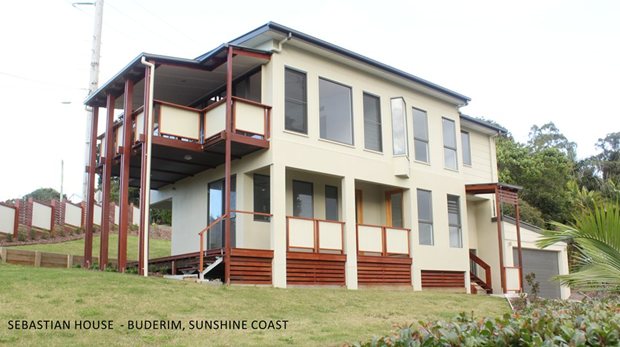
-
House has an effective home envelope, air distribution, water heating equipment, water saving AAA rating showerheads, low-flow sink and bathtub and toilets with dual flush capabilities, an efficient energy star lighting and energy star appliances.
-
The innovative design decisions were made for this project with regard to improve the living quality inside the house on its specific site. These include:
-
To take advantage of beautiful views from the first floor and to shelter habitable areas from the noisy road, the traditional house design approach, where living areas are
-
Located on ground level and bedrooms are above, were reversed in this project.
-
To highlight 360 degrees views from located on first floor kitchen, dining, living and master bedrooms areas, several “pictures” windows were created.
-
A greater feeling of space in this small house was achieved trough the use of high ceilings and the reduction of dead space.
-
All internal and external openings on the first floor together with the stairs central open void were created to allow light to carve up the spaces around the house and visually to make this small house look more specious.
-
Not only the choices of environmental product were incorporated in to the project design, but also greener options were chosen in its construction techniques.
-
Lightweight construction and materials with low BMS were chosen for the walls structure (James Hardie Scyon, Easy Lap, Stria, Axon cladding and Scyon trim; timber
-
frame and plasterboard), suspended timber floor and piers for the floor structure and timber frame with corrugated steel roof for the roof structure.
-
Environmentally preferable and local building materials, appliances, lighting (“Cosmaluce” Green Eco low energy lighting), flooring, countertops, paints and finishes were specified externally and internally for this project.
-
Promotion and use of recycled, recyclable and restored materials together with waste minimization and recycling were implemented on site during the house construction.
-
In this project off cuts from the house walls “Axon” cladding were used to construct the house first floor balustrade and the privacy fence along busy Jones Road. This design decision during the house construction not only allowed to make savings but also improved external project appearance.
-
Some recycled timber was used internally and externally.
FIVE COURTS HOUSE
Matthew Gribben Architecture
The Five Courts House is a contemporary residence within an enclosing series of weathered and recycled brick walls. This urban house is oriented around a primary north facing courtyard, with a string of more intimate courtyards spread around its perimeter.
The site is formed out of the left over space between the intersections of conflicting neighbourhood grids, a residual urban space of unorthodox geometry.
Recycled bricks are stacked upon the existing brick walls in a series of distorted gables. Where these gables connect to courtyards on the interior, the brick is laid in an open course pattern that promotes the passage of light and air without sacrificing the introspective focus of the house.
Passive solar design principles give rise to the predominant northerly orientation with the house laid out around a large north facing courtyard. Supplementary courtyards arranged against the existing masonry walls afford more intimate opportunities for contact with nature. The stealth profile of the house from the street belies the permeability of the facades arranged to the elements. Spaces are organised to provide a linear transition from lesser to greater privacy.
INITIATIVES
-
Low energy light fittings (predominantly LED, and some compact fluorescent) are used throughout.
-
Natural lighting is provided in abundance via the five courtyards that structure the room layout.
-
Water is harvested from the roof to supply a water tank for irrigation needs to the native landscaping.
-
Low-flow sanitary fixtures are used throughout.
-
Existing building fabric, in the form of masonry perimeter walls, are retained and used as the exterior walls of the house.
-
Recycled bricks are used to build up these walls, to provide a low energy source of building materials that creates a timeless character for the house.
-
The program of the house has been distributed across the site to optimise environmentally sustainable design features. Passive solar design principles give rise to the predominant northerly orientation with the house laid out around a large north facing courtyard. Overhangs and operable shading control summer heat gain and permit winter solar access. Supplementary courtyards arranged against the existing masonry walls afford more intimate opportunities for contact with nature.
-
Shaded outdoor space is provided for optimised cross ventilation flows across the range of seasonal and weather conditions. The existing perimeter walls provide excellent insulation to the south and protection from the heat of afternoon sun to the west.
-
Roof water is captured and recycled on site. Hot water heating is solar.
-
The existing brick perimeter walls have been retained, and recycled bricks have been laid on top to complete new construction. Plantation and certified hardwood timber has been used throughout.
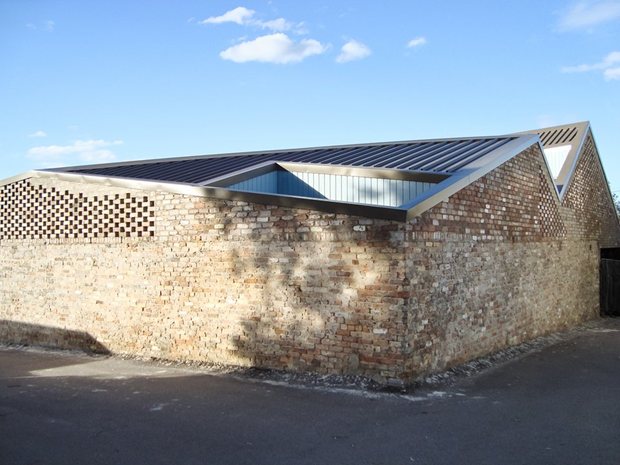
-
Existing brick perimeter walls are retained and repurposed as the exterior walls of the house.
-
Recycled bricks are built up on top of the existing brick perimeter walls to provide material continuity.
-
Plantation and certified hardwood timber has been used throughout.
-
Solar hot water heating.
-
Water tank.
-
Were recyclable building practices implemented on site?
-
The use of repetitive dimensions for the primary building elements limits unnecessary waste, as well as cost.
-
Existing brick perimeter walls are retained and repurposed as the exterior walls of the house.
-
Recycled bricks are built up on top of the existing brick perimeter walls to provide material continuity.
MARION HOUSE
Positive Footprints
Being previously stationed at Mawson in Antarctica, the client learnt the value of efficient resource use. Along with his wife, a committed environmentalist, and 2 young children they wanted a similarly efficient house in line with their view of treading lightly.
North to the street meant large windows for solar performance would have privacy issues.
Solution: Setting only the study to the front setback line and kicking back the lounge into an L-shaped sun-trap gave both a buffer from the street, and space for a garden outlook.
Solar access to southern-side living areas is difficult on a North-South block.
Solution: Clerestory windows over a vaulted mid section to bring sunlight to the core of the house, and internal glazed elements allow rays to continue to the south living/rumpus.
INITIATIVES
-
The design seeks to take a holistic passive solar approach in making the most of the natural resources and energy flows available to the site. These resources were:
-
Sunlight:
-
Melbourne is a primarily heating climate.
-
Sunlight has been harnessed for:
-
Space Heating
-
The design maximises solar heat gains by placing large northern windows to bring sunlight deep into the house. Eaves allow full winter penetration but shade out the summer sun. A highly insulated building fabric then traps this heat in winter, and excludes it in summer.
-
Evacuated-tube solar hot water provides 80per cent of the hot water needs.
-
A 2.2 kilowatt panel system offsets the house’s energy use, producing more energy than used over a year.
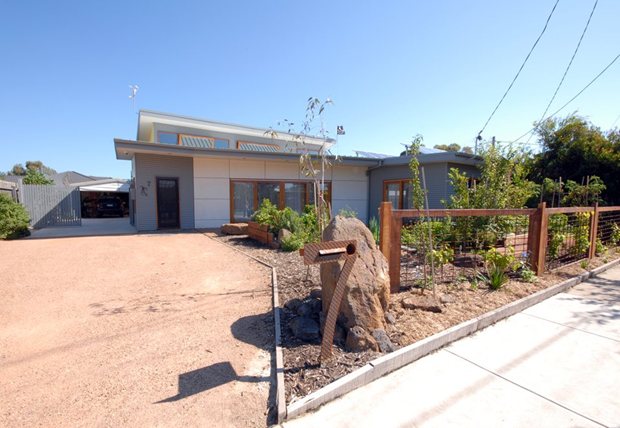
-
Breezes have been harnessed for:
-
Cooling
-
The rear inverted veranda funnels these breezes over living spaces all aligned to this breeze path.
-
Night Purging
-
Casement windows scoop evening breezes cooling the house in summer.
-
Opening the large clerestory windows at the ceiling apex encourages warm air to rise and exit, drawing in cool air to replace it.
-
Melbourne has moderate to large diurnal temperature swings.
-
Mass has been harnessed for:
-
Thermal Stability
-
Thermal mass in the slab, enhanced by a dark polished concrete floor, moderates temperature extremes and provides a thermal reservoir for both heat retention in winter and cooling capacity in summer.
-
Flushing toilets and supplying laundry internally, and garden irrigation. Rain supplies 70per cent of water requirements.
-
Soil has been harnessed for:
-
Providing bounty
-
Irrigation from the watertank, combined with full solar access to the front garden
SHLEGERIS RESIDENCE
WD Architects
The brief was to design a sustainable house that is highly energy-efficient, low maintenance where possible; timber to feature heavily and little or no plasterboard.
A large north-facing roof area for solar array was incorporated along with energy-efficient lighting throughout.
The orientation of the suburban block is 28 degrees off north, making it a challenge to have the solar panels facing true north for best efficiency, and also making sun shading more difficult than a block oriented to north. We addressed this by skewing the main roof to the block, to face true north. This roof therefore became a dominant design feature of the house, creating dynamic internal forms.
Effective cross-ventilation achieved through all rooms, including the two 'internal' study areas.
INITIATIVES
-
Sun shading locations and size determined through sun studies and computer modelling.
-
Insulation levels and detailing to suit the subtropical climate. * Specs to suit the saltwater environment.
-
Landscaping to encourage native birds and butterflies.
-
Subfloor perimeter of the building is enclosed and insulated to create a buffer of 'dead air' under the house, thus getting the benefit of the stable earth temperature for summer cooling and winter heating.
-
Kayak storage is placed under the front of the house for ease of access to the lake across the street.
-
Fencing and general design of the house make it such that the garage door can stay open most of the time, thus access to bicycles is encouraged.
-
Large solar array and solar HWU take advantage of the ample free energy from the sun in this location.
-
Large outdoor areas integrated with internal spaces.
-
Ceiling fans to all major rooms and main deck.
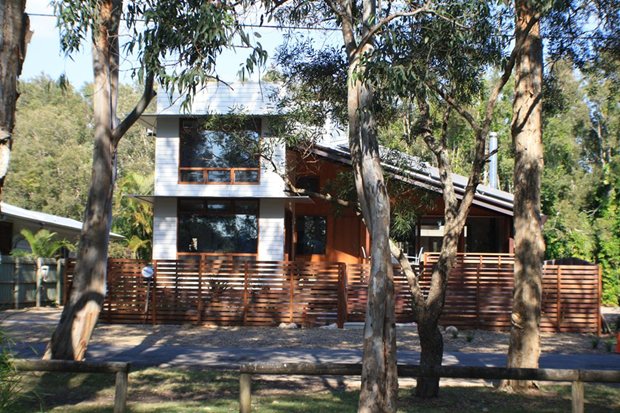
-
Height restrictions (both minimum floor level for flooding and maximum height above ground) created challenges; thermal mass and thus high energy rating was difficult to achieve due to requirement for elevated floor.
-
Width of site and required setbacks made it impractical to rotate the house to achieve good orientation.
-
BAL 12 and 19 bushfire ratings.
-
Nothing uses stand-by power therefore there are no remotes and everything is hardwired and able to be switched off at wall.
-
The 10 kilowatt photovoltaic system produces far more electricity than the owners consume. PV array is pronounced.
-
100per cent of fixed lighting is energy-efficient LED.
-
Water: This house has a single 5000 liter tank. This supplies the outdoor taps, the toilets, and the washing machine. In the first three months of occupation, about 30per cent of the total water usage has come from the tank. Gardens are water-efficient natives.
-
The water heater is a 22-tube evacuated tube system with a 360 liter tank.
-
Chickens in the back yard eat almost all food scraps, thus significantly reducing rubbish to landfill (owners thus have a small-size wheelie bin which saves $100 in rates per year)
Shlegaris image courtesy of Andrew Webb
+-+Sustainability+Awards+2012+finalists+%7c+Architecture+%26+Design&pu=/awards-1/past-awards/single-dwelling-new-sustainability-awards-2012-fin&pt=_Article)
+-+Sustainability+Awards+2012+finalists+%7c+Architecture+%26+Design&pu=/awards-1/past-awards/single-dwelling-new-sustainability-awards-2012-fin&pt=_Article)